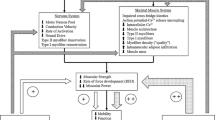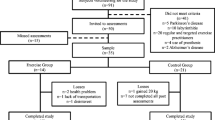Abstract
Fatigue is common in older adults and has a significant effect on quality of life. Despite the high prevalence of fatigue in older individuals, several aspects are poorly understood. It is important to differentiate subjective fatigue complaints from fatigability of motor performance because the two are independent constructs with potentially distinct consequences on mobility. Performance fatigability is the magnitude of change in a performance criterion over a given time of task performance. Performance fatigability is a compulsory element of any strength training program, yet strength training is an important component of rehabilitation programs for older adults. The consequences of fatigability for older adults suggest that acute exercise of various types may result in acute impairments in postural control. The effects of performance fatigability on postural control in older adults are evaluated here to aid the rehabilitation clinician in making recommendations for evaluation of fall risks and exercise prescription.
Similar content being viewed by others
References
Papers of particular interest, published recently, have been highlighted as: • Of importance •• Of major importance
Wijeratne C, Hickie I, Brodaty H. The characteristics of fatigue in an older primary care sample. J Psychosom Res. 2007;62(2):153–8.
Liao S, Ferrell BA. Fatigue in an older population. J Am Geriatr Soc. 2000;48(4):426–30.
Enoka RM, Duchateau J. Translating fatigue to human performance. Med Sci Sports Exerc, 2016. A case is made for a unified definition of fatigue to facilitate its management in health and disease.
Deluca J. Fatigue as a Window to the Brain. Cambridge: MIT Press; 2005.
Gandevia S, McComas A, Stuart D, Thomas C. Fatigue: Neural and Muscular Mechanisms. New York: Plenum; 1995.
Kluger BM, Krupp LB, Enoka RM. Fatigue and fatigability in neurologic illnesses: proposal for a unified taxonomy. Neurology. 2013;80(4):409–16.
Gandevia SC. Spinal and supraspinal factors in human muscle fatigue. Physiol Rev. 2001;81(4):1725–89.
Helbostad JL, Sturnieks DL, Menant J, Delbaere K, et al. Consequences of lower extremity and trunk muscle fatigue on balance and functional tasks in older people: a systematic literature review. BMC Geriatr. 2010;10:56.
Shumway-Cook A, WM. Motor control: theory and practical applications 2nd ed. Baltimore, MD: Lippincott Williams & Wilkins; 2001.
Horak F, Kuo A. Postural adaptations for altered environments, tasks, and intentions. In: Winters JM, Crago PE, editors. Biomechanics and neural control of posture and movement. New York: Springer; 2000. p. 683.
Paillard T. Effects of general and local fatigue on postural control: a review. Neurosci Biobehav Rev. 2012;36(1):162–76.
Papa EV, Foreman KB, Dibble LE. Effects of age and acute muscle fatigue on reactive postural control in healthy adults. Clinical Biomechanics, 2015;30(10):1108–13. Timeline of recovery of postural control from performance fatigability is reported.
Fleck SJ Kraemer W. Designing resistance training programs, 4th Ed. Champaign, IL: Human Kinetics; 2014.
Medicine ACoS. ACSM’s guidelines for exercise testing and prescription. 9th ed. Philadelphia, PA: Lippincott Williams & Wilkins; 2013.
Fiatarone MA, O’Neill EF, Ryan ND, Clements KM, et al. Exercise training and nutritional supplementation for physical frailty in very elderly people. N Engl J Med. 1994;330(25):1769–75.
Trappe S, Williamson D, Godard M. Maintenance of whole muscle strength and size following resistance training in older men. J Gerontol A Biol Sci Med Sci. 2002;57(4):B138–43.
Fried LP, Tangen CM, Walston J, Newman AB, et al. Frailty in older adults: evidence for a phenotype. J Gerontol A Biol Sci Med Sci. 2001;56(3):M146–56.
Davis M, Fitts R. In: Roitman J, editor. Mechanisms of muscular fatigue, in ACSM’s Resource Manual for Guidelines for Exercise Testing and Prescription. Philadelphia, PA: Lippincott Williams & Wilkins; 2001. p. 184.
Stackhouse SK, Stevens JE, Lee SC, Pearce KM, et al. Maximum voluntary activation in nonfatigued and fatigued muscle of young and elderly individuals. Phys Ther. 2001;81(5):1102–9.
Allman BL, Rice CL. Incomplete recovery of voluntary isometric force after fatigue is not affected by old age. Muscle Nerve. 2001;24(9):1156–67.
Smolander J, Aminoff T, Korhonen I, Tervo M, et al. Heart rate and blood pressure responses to isometric exercise in young and older men. Eur J Appl Physiol Occup Physiol. 1998;77(5):439–44.
Ditor DS, Hicks AL. The effect of age and gender on the relative fatigability of the human adductor pollicis muscle. Can J Physiol Pharmacol. 2000;78(10):781–90.
Bemben MG, Massey BH, Bemben DA, Misner JE, et al. Isometric intermittent endurance of four muscle groups in men aged 20–74 yr. Med Sci Sports Exerc. 1996;28(1):145–54.
Bilodeau M, Erb MD, Nichols JM, Joiner KL, et al. Fatigue of elbow flexor muscles in younger and older adults. Muscle Nerve. 2001;24(1):98–106.
Kent-Braun JA. Skeletal muscle fatigue in old age: whose advantage? Exerc Sport Sci Rev. 2009;37(1):3–9.
Avin KG, Law LA. Age-related differences in muscle fatigue vary by contraction type: a meta-analysis. Phys Ther. 2011;91(8):1153–65.
Neumann DA. Kinesiology of the musculoskeletal system : foundations for rehabilitation. 2nd ed. St. Louis, Mo: Mosby/Elsevier; 2010. p. 725.
Papa EV, Garg H, Dibble LE. Acute effects of muscle fatigue on anticipatory and reactive postural control in older individuals: a systematic review of the evidence. J Geriatr Phys Ther, 2015;38(1):40–8. Systematic review of effects of fatigability on different aspects of postural control, including anticipatory and reactive mechanisms.
Hsiao-Wecksler ET. Biomechanical and age-related differences in balance recovery using the tether-release method. J Electromyogr Kinesiol. 2008;18(2):179–87.
Toebes MJ, Hoozemans MJ, van Dieen JH DJ. Effects of unilateral leg muscle fatigue on balance control in perturbed and unperturbed gait in healthy elderly. Gait Posture. 2014;40(1):215–9.
Nam HS, Park DS, Kim DH, Kang HJ, et al. The relationship between muscle fatigue and balance in the elderly. Ann Rehabil Med. 2013;37(3):389–95.
Bisson EJ, Lajoie Y, Bilodeau M. The influence of age and surface compliance on changes in postural control and attention due to ankle neuromuscular fatigue. Exp Brain Res. 2014;232(3):837–45.
Arvin M, Hoozemans MJ, Burger BJ, Rispens SM, et al. Effects of hip abductor muscle fatigue on gait control and hip position sense in healthy older adults. Gait Posture. 2015;42(4):545–9.
Parreira RB, Amorim CF, Gil AW, Teixeira DC, et al. Effect of trunk extensor fatigue on the postural balance of elderly and young adults during unipodal task. Eur J Appl Physiol. 2013;113(8):1989–96. Timeline of recovery of postural control from performance fatigability is reported.
Rubenstein LZ. Falls in older people: epidemiology, risk factors and strategies for prevention. Age Ageing. 2006;35 Suppl 2:ii37–41.
Hatton AL, Menant JC, Lord SR, Lo JC, et al. The effect of lower limb muscle fatigue on obstacle negotiation during walking in older adults. Gait Posture. 2013;37(4):506–10.
Parijat P, Lockhart TE. Effects of lower extremity muscle fatigue on the outcomes of slip-induced falls. Ergonomics. 2008;51(12):1873–84.
Doheny EP, Greene BR, Foran T, Cunningham C, et al. Diurnal variations in the outcomes of instrumented gait and quiet standing balance assessments and their association with falls history. Physiol Meas. 2012;33(3):361–73.
Boulgarides LK, McGinty SM, Willett JA, Barnes CW. Use of clinical and impairment-based tests to predict falls by community-dwelling older adults. Phys Ther. 2003;83(4):328–39.
Tromp AM, Pluijm SM, Smit JH, Deeg DJ, et al. Fall-risk screening test: a prospective study on predictors for falls in community-dwelling elderly. J Clin Epidemiol. 2001;54(8):837–44.
Bonen A, Belcastro AN. Comparison of self-selected recovery methods on lactic acid removal rates. Med Sci Sports. 1976;8(3):176–8.
Gisolfi C, Robinson S, Turrell ES. Effects of aerobic work performed during recovery from exhausting work. J Appl Physiol. 1966;21(6):1767–72.
Harkins KM, Mattacola CG, Uhl TL, Malone TR, et al. Effects of 2 ankle fatigue models on the duration of postural stability dysfunction. J Athl Train. 2005;40(3):191–4.
Yaggie JA, McGregor SJ. Effects of isokinetic ankle fatigue on the maintenance of balance and postural limits. Arch Phys Med Rehabil. 2002;83(2):224–8.
Rybar MM, Walker ER, Kuhnen HR, Ouellette DR, et al. The stroke-related effects of hip flexion fatigue on over ground walking. Gait Posture. 2014;39(4):1103–8.
Papa E, Foreman B, Dibble L. “Going backwards”: effects of age and muscle fatigue on postural control during posterior-directed falls in persons with Parkinson disease. Physiotherapy. 2015;101:e1170–1.
Hunter SK, Critchlow A, Enoka RM. Influence of aging on sex differences in muscle fatigability. J Appl Physiol (1985). 2004;97(5):1723–32.
Law LAF, Avin KG. Endurance time is joint-specific: a modelling and meta-analysis investigation. Ergonomics. 2010;53(1):109–29.
Hunter S. Aging and mechanisms of task-dependent muscle fatigue. Advances in neuromuscular physiology of motor skills and muscle fatigue. Kerala, India: Research Signpost; 2009. p. 391–414.
Bazzucchi I, Marchetti M, Rosponi A, Fattorini L, et al. Differences in the force/endurance relationship between young and older men. Eur J Appl Physiol. 2005;93(4):390–7.
Author information
Authors and Affiliations
Corresponding author
Ethics declarations
Conflict of Interest
Evan Papa reports grants from NIH/NCATS KL2TR001103 during the conduct of the study.
Nicoleta Bugnariu reports grants from NSF/NRI-1208623 during the conduct of the study.
Mahdi Hassan reports no conflict of interest.
Human and Animal Rights and Informed Consent
This article does not contain any studies with human or animal subjects performed by any of the authors.
Additional information
This article is part of the Topical Collection on Physical Therapy and Rehabilitation
Rights and permissions
About this article
Cite this article
Papa, E.V., Hassan, M. & Bugnariu, N. The Effects of Performance Fatigability on Postural Control and Rehabilitation in the Older Patient. Curr Geri Rep 5, 172–178 (2016). https://doi.org/10.1007/s13670-016-0179-4
Published:
Issue Date:
DOI: https://doi.org/10.1007/s13670-016-0179-4




